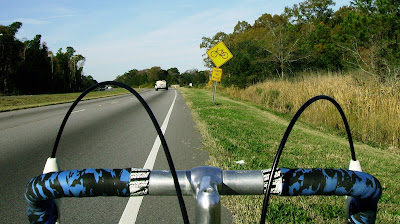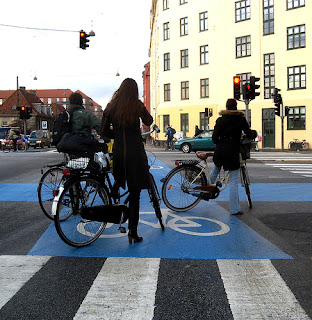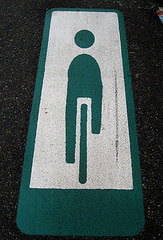What does share the road really mean?
 Sun, March 30, 2008
Sun, March 30, 2008 
The following comment was made on my last post:
"I agree that we all share the roads, etc. What I do not understand is cyclists who will steadfastly ride in the middle of a thoroughfare lane while cars back up for blocks behind them not being able to pass.
Sure, bikes have as much right as anyone else to be on the street, but what they do not have the right to do is block a lane or impede traffic.
Politeness and common sense dictate that they get out of the way and allow others to pass if they cannot keep up with the flow of traffic."
To many non-cyclists “Share the road” means, “Okay I accept that you have a right to be on the road, but just stay out of my way.” This comes through in the last sentence of the above comment.
Politeness and common sense need to prevail on both sides, otherwise it is not a true “Sharing” of the road. I would be happy to stay out of the way and ride to the extreme right, if in return other road users would have a little concern for my safety and not pass me at 50 or 60 mph, missing me by inches.
Most people drive in the middle of the lane leaving equal space to the edge of the lane on either side. Many will simply hold that line when passing a cyclist, when “Politeness and common sense” would suggest steering to the outside edge of the lane thereby leaving more space on the inside.
If it is a two-lane, divided highway, and there is no one along side or about to overtake, signal and move to the other lane, or at least put the car’s wheels over the line. The same on narrow rural roads, cross that center line if it can be done safely, if not, stay behind for a brief moment, and then pass. A cyclist is less than 7 feet long and 3 feet wide, it is not like passing an eighteen-wheeler.
Many states are bringing in new laws to give cyclists a minimum of 3 feet when passing. If politeness and common sense prevailed, these laws would be unnecessary. So in the mean time, I exercise my right to “take the lane,” in other words move to the center of the lane when it is unsafe to pass.
A good example of this would be where there are cars parked at the side of the road. I will not ride within 5 feet of a parked car because people will fling open car doors without warning. Five feet will usually put me in the middle of the lane, if I ride any closer cars will still continue to pass at their normal speed.
If someone opens a car door I have nowhere to go. I am not only injured by running into the edge of the door, I will most likely fall in the path of a passing car. It is unfortunate that city planners allow parking for long stretches of city roads, without understanding the real danger this imposes on cyclists.
Another situation where I would take the lane is if I want to make a left turn ahead. (Right turn in the UK.) On a multi-lane highway I may need to start the maneuver several blocks before I actually turn.
From the right lane I will wait for a gap in traffic, signal and move to the center of the lane, stopping any further traffic from passing. I cannot safely get into the second lane from the extreme right edge of the first lane.
Then when there is a gap in traffic in the second lane, I signal move over again. Sometimes an impatient driver will also see this gap and try to go around me. If this stops me from changing lanes then all the traffic behind me continues to be delayed because one selfish driver didn’t allow me to get over and move out of the way.
When I reach the left turn lane, I stay in the middle of that lane. If I move to the left of the lane, cars will pass me on the outside and after I complete the turn, I am now stuck in the middle, needing to get back over to the right.
If I move to the right side of the turn lane, now I have traffic passing at speed on both sides. If one should hit me, I would be knocked into the path of another vehicle.
This is often a left turn at a traffic light. Everyone is rushing to make the green light, no one is concerned for my safety except me, so forgive me if I appear a little “selfish” at this point.
More people would commute to work by bicycle but they see it as dangerous. As time goes by, economic reasons will force some to overcome this fear. Every bicycle on the road means one less car; people will become more aware of bicycles and drive slower and with caution. People will actually get to their destination quicker and safer because there will be less congestion.
Footnote:
The picture at the top is Savannah Hwy. (Rt. 17.) the main road south out of Charleston, South Carolina where I live. Traffic is heavy during the week, but moderate at weekends. Not the best place to ride, but necessary to get from where I live to some of the more rural areas on John’s Island, and Wadmalaw Island.
The road has a narrow shoulder and “Share the road” signs are posted. It is a divided highway with two wide traffic lanes in either direction. I ride on the shoulder and in spite of this drivers will pass me within inches at 50 to 60 mph as I described earlier, even though there is no traffic in the outside lane.
I use my “take the lane” right sparingly and only when absolutely necessary. If I delay other road users briefly, I am doing it in the interest of my own safety, not just to piss people off.
 Dave Moulton | Comments Off |
Dave Moulton | Comments Off | 




















